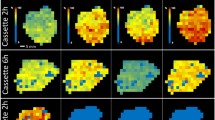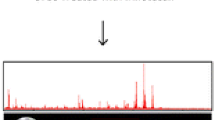Abstract
The aim of this study was to establish an ex vivo model for a faster optimisation of sample preparation procedures, for example matrix choice, in matrix-assisted laser desorption/ionisation (MALDI) drug imaging studies. The ionisation properties of four drugs, afatinib, erlotinib, irinotecan and pirfenidone, were determined in an ex vivo tissue experiment by spotting decreasing dilution series onto liver sections. Hereby, the drug signals were distinctly detectable using different matrix compounds, which allowed the selection of the optimal matrix for each drug. The analysis of afatinib and erlotinib yielded high drug signals with α-cyano-4-hydroxycinnamic acid matrix, whereas 2,3-dihydroxybenzoic acid was identified as optimal matrix for irinotecan and pirfenidone detection. Our method was validated by a MALDI drug imaging approach of in vivo treated mouse tissue resulting in corresponding findings, indicating the spotting method as an appropriate approach to determine the matrix of choice. The present study shows the accordance between the detection of ex vivo spotted drugs and in vivo administered drugs by MALDI-TOF and MALDI-FT-ICR imaging, which has not been demonstrated so far. Our data suggest the ex vivo tissue spotting method as an easy and reliable model to optimise MALDI imaging measurements and to predict drug detection in tissue sections derived from treated mice prior to the recruitment of laboratory animals, which helps to save animals, time and costs.






Similar content being viewed by others
References
Balluff B, Schöne C, Höfler H, Walch A (2011) MALDI imaging mass spectrometry for direct tissue analysis: technological advancements and recent applications. Histochem Cell Biol 136(3):227–244
Castellino S, Groseclose MR, Wagner D (2011) MALDI imaging mass spectrometry: bridging biology and chemistry in drug development. Bioanalysis 3(21):2027–2441
Chughtai K, Heeren RM (2010) Mass spectrometric imaging for biomedical tissue analysis. Chem Rev 110(5):3237–3277
Ellis SR, Bruinen AL, Heeren RM (2014) A critical evaluation of the current state-of-the-art in quantitative imaging mass spectrometry. Anal Bioanal Chem 406(5):1275–1289
Goodwin RJ, Mackay CL, Nilsson A, Harrison DJ, Farde L, Andren PE, Iverson SL (2011) Qualitative and quantitative MALDI imaging of the positron emission tomography ligands raclopride (a D2 dopamine antagonist) and SCH 23390 (a D1 dopamine antagonist) in rat brain tissue sections using a solvent-free dry matrix application method. Anal Chem 83(24):9694–9701
Gosselin LE, Williams JE, Personius K, Farkas GA (2007) A comparison of factors associated with collagen metabolism in different skeletal muscles from dystrophic (mdx) mice: impact of pirfenidone. Muscle Nerve 35(2):208–216
Groseclose MR, Castellino S (2013) A mimetic tissue model for the quantification of drug distributions by MALDI imaging mass spectrometry. Anal Chem 85(21):10099–10106
Grüner BM, Ardito CM, Takeuchi KK, Lubeseder-Martellato C, Teichmann N, Mazur PK, DelGiorno KE, Carpenter ES, Halbrook CJ, Hall JC, Pal D, Briel T, Herner A, Trajkovic-Arsic M, Sipos B, Liou G, Storz P, Murray NR, Threadgill DW, Sibilia M, Washington MK, Wilson CL, Schmid RM, Raines EW, Crawford HC, Siveke JT (2012) EGF receptor is required for KRAS-induced pancreatic tumorigenesis. Cancer Cell 22(3):304–317
Hamm G, Bonnel D, Legouffe R, Pamelard F, Delbos JM, Bouzom F, Stauber J (2012) Quantitative mass spectrometry imaging of propranolol and olanzapine using tissue extinction calculation as normalization factor. J Proteomics 75(16):4952–4961
Kakugawa T, Mukae H, Hayashi T, Ishii H, Abe K, Fujii T, Oku H, Miyazaki M, Kadota J, Kohno S (2004) Pirfenidone attenuates expression of HSP47 in murine bleomycin-induced pulmonary fibrosis. Eur Respir J 24(1):57–65
Källback P, Shariatgorji M, Nilsson A, Andrén PEJ (2012) Novel mass spectrometry imaging software assisting labeled normalisation and quantitation of drugs and neuropeptides directly in tissue sections. J Proteomics 75(16):4941–4951
Kawato Y, Aonuma M, Hirota Y, Kuga H, Sato K (1991) Intracellular roles of SN-38, a metabolite of the camptothecin derivative CPT-11, in the antitumor effect of CPT-11. Cancer Res 51(16):4187–4191
Ling J, Johnson KA, Miao Z, Rakhit A, Pantze MP, Hamilton M, Lum BL, Prakash C (2006) Metabolism and excretion of erlotinib, a small molecule inhibitor of epidermal growth factor receptor tyrosine kinase, in healthy male volunteers. Drug Metab Dispos 34(3):420–426
MacAleese L, Stauber J, Heeren RM (2009) Perspectives for imaging mass spectrometry in the proteomics landscape. Proteomics 9(4):819–834
Moore M, Hirte HW, Siu L, Oza A, Hotte SJ, Petrenciuc O, Cihon F, Lathia C, Schwartz B (2005) Phase I study to determine the safety and pharmacokinetics of the novel Raf kinase and VEGFR inhibitor BAY 43-9006, administered for 28 days on/7 days off in patients with advanced, refractory solid tumors. Ann Oncol 16(10):1688–1694
Murakami M, Zhao S, Zhao Y, Yu W, Fatema CN, Nishijima KI, Yamasaki M, Takiguchi M, Tamaki N, Kuge Y (2013) Increased intratumoral fluorothymidine uptake levels following multikinase inhibitor sorafenib treatment in a human renal cell carcinoma xenograft model. Oncol Lett 6(3):667–672
Neubert P, Walch AK (2013) Current frontiers in clinical research application of MALDI imaging mass spectrometry. Expert Rev Proteomics 10(3):259–273
Nilsson A, Fehniger TE, Gustavsson L, Andersson M, Kenne K, Marko-Varga G, Andrén PE (2010) Fine mapping the spatial distribution and concentration of unlabeled drugs within tissue micro-compartments using imaging mass spectrometry. PLoS ONE 5(7):e11411
Norris JL, Caprioli RM (2013) Analysis of tissue specimens by matrix-assisted laser desorption/ionization imaging mass spectrometry in biological and clinical research. Chem Rev 113(4):2309–2342
Pirman DA, Reich RF, Kiss A, Heeren RM, Yost RA (2013) Quantitative MALDI tandem mass spectrometric imaging of cocaine from brain tissue with a deuterated internal standard. Anal Chem 85(2):1081–1089
Prideaux B, Stoeckli M (2012) Mass spectrometry imaging for drug distribution studies. J Proteomics 75(16):4999–5013
Schwartz SA, Reyzer ML, Caprioli RM (2003) Direct tissue analysis using matrix-assisted laser desorption/ionisation mass spectrometry: practical aspects of sample preparation. J Mass Spectrom 38(7):699–708
Stoeckli M, Staab D, Schweitzer A (2007) Compound and metabolite distribution measured by MALDI mass spectrometry imaging in whole-body tissue sections. Int J Mass Spectrom 160(2–3):195–202
Sun N, Walch A (2013) Qualitative and quantitative mass spectrometry imaging of drugs and metabolites in tissue at therapeutic levels. Histochem Cell Biol 140(2):39–104
Weaver Z, Difilippantonio S, Carretero J, Martin PL, El Meskini R, Iacovelli AJ, Gumprecht M, Kulaga A, Guerin T, Schlomer J, Baran M, Kozlov S, McCann T, Mena S, Al-Shahrour F, Alexander D, Wong K, Van Dyke T (2012) Temporal molecular and biological assessment of an erlotinib-resistant lung adenocarcinoma model reveals markers of tumor progression and treatment response. Cancer Res 72(22):5921–5933
Zaima N, Hayasaka T, Goto-Inoue N, Setou M (2010) Matrix-assisted laser desorption/ionisation imaging mass spectrometry. Int J Mol Sci 11(12):5040–5055
Acknowledgments
We thank Jolanta Slawska for excellent technical assistance. The study was supported by Ministry of Education and Research of the Federal Republic of Germany (BMBF) (Grant Nos. 01IB10004E, 01ZX1310B), the Deutsche Forschungsgemeinschaft (Grant Nos. HO 1258/3-1, SFB 824 TP Z02 and WA 1656/3-1) to AW and SFB 824 C5 to UK, and Helmholtz Zentrum München (TKP-Project) to OE and AW.
Author information
Authors and Affiliations
Corresponding author
Rights and permissions
About this article
Cite this article
Huber, K., Aichler, M., Sun, N. et al. A rapid ex vivo tissue model for optimising drug detection and ionisation in MALDI imaging studies. Histochem Cell Biol 142, 361–371 (2014). https://doi.org/10.1007/s00418-014-1223-0
Accepted:
Published:
Issue Date:
DOI: https://doi.org/10.1007/s00418-014-1223-0




